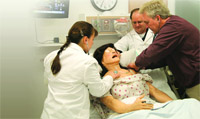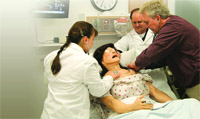
A Case of Supply and Demand
$1.6 Million Grant Will Fund Efforts to Build Awareness of Careers in Health Care

The SIMS Medical Center at Springfield Technical Community College, which uses more than a dozen patient simulators, will be a key component in efforts to raise awareness of opportunities in health care and what’s involved with various careers.
Facing spiraling demand for workers in many health care careers as well as a recognized lack of awareness concerning the many opportunities in this field a host of partners will take a $1.6 million federal grant and put it to work in ways designed to put more employees in the pipeline.
Mike Foss says that Springfield Technical Community College tries to do what he calls exit interviews with individuals who decide to leave the schools various health programs before graduating.
There are several reasons why they might do so, said Foss, STCCs dean of the School of Health and Patient Simulation, who told BusinessWest that the college has been charting responses, unofficially at least, for some time now. Sometimes its finances, other times there are personal issues, and they need to drop out. And sometimes they just disappear and dont give a reason.
But many times, people will say that they just had no clue about what they were really getting into, he continued, adding that often this means they found themselves in over their heads, and other times that they were preparing for work that simply didnt intrigue or challenge them to the extent they thought it would.
And while dropping out is certainly a setback for the student in question, career-wise and otherwise, he continued, it is for the health care community as well, because it means there will be one fewer person entering a field such as nursing, physical or occupational therapy, or radiology, at a time when the industry is desperate for qualified people in those and many other professions.
Thus, reducing the number of people who might someday say they didnt know what they were getting into when they enter a health program is one of many outcomes Foss and a host of others will work to achieve through a $1.65 million, three-year grant from the U.S. Labor Department. The grant was given to STCC, but it is intended for what Foss calls an unprecedented collaboration involving no fewer than 16 partners.
These range from the three other community colleges in Western Mass. (Holyoke, Berkshire, and Franklin) to several regional employment boards; from major employers, including several area hospitals, to The World Is Our Classroom; from Springfield Public Schools to the Mason Square Veterans Outreach Center.
Together, all those involved with the Community Based Job Training Grant, as its called, will work to make people of various age and demographic groups more aware of the many career paths that can be taken in health care, and also the academic preparation needed to get into specific fields and the rigors of the courses of study.
Such insight is necessary, Foss told BusinessWest, because despite widespread focus in the press on shortages of personnel in several health care fields, many people are simply not aware of what opportunities exist beyond becoming a physician or a nurse.
When people come to us and say, I want to be a fill-in-the-blank, usually a nurse, he explained, noting that by us he means area colleges, health care providers, and other constituencies, well ask, what other fields in health have you considered? And theyll look at you like they dont know what youre talking about, because all they know is nurses and doctors.
Jean Jackson agreed. As vice president of Workforce Planning for Baystate Health, she will be one of those developing strategies for filling an estimated 10,000 positions (new and created through retirement and attrition) over the next 10 years or so, and she knows this will be an extreme challenge in many fields, due in part to that lack of awareness when it comes to options and opportunities in this sector.
Unless youre in health care or know someone who works in health care and youre exposed to it, youre probably not aware of all the different opportunities that exist, she said. Someone can apply to nursing school, not get in, and not be aware that there are many other attractive alternatives.
Kelly Aiken, project manager with the Regional Employment Board of Hampden County, said there are a number of quantifiable and qualifiable goals with regard to the grant-funded initiatives, including an across-the-board increase in applications for health care programs at area colleges; reaching full capacity for these programs or getting much closer to that mark; increasing graduation rates in many programs; and, in general, producing graduates that are able to meet the needs of area health care providers.
When asked when the region could or should expect to see progress in these realms, Aiken told BusinessWest that it would be difficult to give a more scientific answer than as soon as possible. But she and others certainly hope to see recognizable improvement by 2015. Thats the date many experts have identified as a critical point, when the region and nation will certainly be feeling the impact from a wave of retirements in nursing and other fields, as well as soaring needs for the huge (and aging) baby boom generation.
It will be a perfect storm of conditions, she said of that not-so-far-off time. And we need to be ready for that storm.
Course of Action
Aiken told BusinessWest that the various initiatives to be spawned through the Community Based Job Training Grant will dovetail with other health care workforce-building efforts created and funded through a host of programs with some serious acronyms.
For example, theres Collaborating for the Advancement of Nursing: Developing Opportunities, or CAN DO, a program funded through the Robert Wood Johnson Foundation that is designed to put more nurses in the pipeline and provide incentives for those in the field to pursue advanced degrees so they can teach the subject and thus help bolster the ranks.
Theres also a broad initiative to put more health care workers in the flow that is part of the region-wide program called Building a Better Workforce Closing the Skills Gap on the Road to Economic Resurgence. That project is designed to clear pathways for lower-skilled incumbent workers by providing certified nursing assistant (CNA) and acute-care training.
Motivation for these various endeavors is supplied by trends and statistics clearly indicating growing demand for workers in a number of fields across health care and hard questions about just how all this demand is going to be met. For example, projections from the Bureau of Labor Statistics concerning the fastest-growing jobs between 2006 and 2016 show a list dominated by careers in health care.
Among the top 30 are specialties ranging from personal and home care aides (with projected growth in need of just over 50% by 2016) to physical therapist assistants (32.4%); from pharmacy technicians (32%) to medical assistants (35.4%).
Familiarizing young people (and some who are maybe not so young) with these professions and detailing how one can enter such fields is the broad goal of the Labor Department grant, said Foss, who drew a parallel between this collaborative efforts mission and a spike in interest in the emergency medical technician (EMT) field, and others, after 9/11.
There was a lot of press given to EMTs, paramedics, firefighters, and police, he said of the days, weeks, and months after 9/11. From what we understand, there was a sudden surge in EMT and paramedic programs across the country; the media was making people aware that this was a career possibility.
We want to do the same thing with some of these other careers, he continued, because if a student doesnt really know what the opportunities are, its very difficult for them to make a reasoned and rational decision like maybe I shouldnt be in nuclear medicine; maybe I should be a respiratory therapist.
But individuals need to know more than what the opportunities are, he said, adding that many current applicants for programs are not aware of what theyll need in terms of preparatory course work to be accepted into a program. And thats extremely frustrating.
To address all this, the grant has many provisions. They include:
Study in Contrasts
To execute many of these initiatives, especially the medical encounter and the semester-long course, STCC will make broad use of its SIMS Medical Center (SMC), which uses more than a dozen patient simulators to closely replicate the medical workforce environment of today, said Foss. The center includes a four-bed acute care unit, trauma room, surgical suite, basic care unit, and the two-bed Berkshire Bank Critical Care Unit.
Such exposure will likely eliminate much of the students not knowing what theyre getting into, said Foss, adding that work with the simulators offers first-hand, almost-real-life experience with what it takes to be a health care provider. Theyd be working on these patients as if they were in charge of them.
And the situations that participants will find themselves in should introduce them to a number of different health care professions, he continued. They get to touch the patients and work with them change bandages, check vital signs, do documentation, and learn communications skills. And therell be some blood and gore as well.
All this will hopefully create not only awareness, but interest, said Jackson, noting that, with many health care professions, current supply doesnt meet demand, and demand is only going to increase.
She hopes and expects that the medical encounter and especially the first-year, semester-long course at each community college will help prompt many students who are undecided about which career path to take and many freshmen fall into that category to take a hard look at health care and take that road.
Direct exposure to specific careers and the work involved could help open peoples eyes in ways that literature or even a Web site cannot, she continued.
Instead of just reading or hearing about what a surg-tech (surgical technician) does, people can get a flavor for what the work is really like, Jackson explained, adding that such direct contact will likely help increase graduation rates in various programs down the road.
Meanwhile, there must be simultaneous efforts to build awareness among younger people (in high school and even earlier) so that, when they do graduate, they have the prerequisites needed to pursue health careers in college.
This is where The World Is Our Classroom, which works with area employers to exposes young people to careers in everything from manufacturing to environmental engineering, will play a role, said Aiken, adding that involvement of a host of diverse groups to advance workforce-development strategies is part of a nationwide trend toward what she called sector-based partnerships.
The region is developing several of these partnerships, she told BusinessWest, citing others involving precision manufacturing and early-childhood education, and early-stage work for one in green jobs, for example.
Thats a workforce-development trend, she explained, and one that will help us put our ducks in a row and make us more attractive for more federal funding.
Close Encounters
Summing up the many goals set by the partners involved with the Labor Department grant, Foss said STCC and the other players obviously want to compel more people to explore health care careers and, when the fit is right, pursue one of them.
But beyond that, he said the ultimate goal is to help those who contemplate such moves to make the right decisions and be prepared to be a competent and dedicated health care worker.
If all goes as planned, hell be doing fewer of those exit interviews, and encountering far fewer people who didnt have a clue about what they were getting into.
George OBrien can be reached at[email protected]




